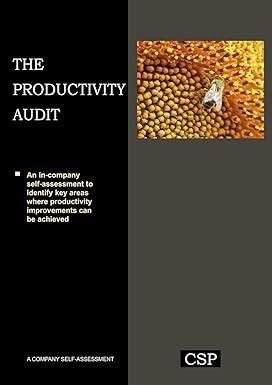Question
The current reliability of Complex GA Aircraft Systems is unknown. The ability to gain insight into this unknown will provide the aviation community with a
The current reliability of Complex GA Aircraft Systems is unknown. The ability to gain insight into this unknown will provide the aviation community with a valuable benchmark that will assist in the development of reliability and safety requirements for future aircraft. This benchmark must be established in order to ensure that technology development, design guidelines, and work on certification standards progresses towards the effective goal of affordable technologies for small engine airplanes. In order to provide relevant information regarding GA aircraft reliability that is conducive to the engineering goal of ensuring development of an affordable, advanced single pilot transportation aircraft, it is necessary to include airplanes that share many of the characteristics of future aircraft design. The proposed future aircraft design will consist of an aircraft with a cruise speed of 160 knots and a range of 700 nm. This aircraft is considered to be a single pilot, four-place, light-single engine piston aircraft with near all weather capability. Complex GA Aircraft have retractable landing gear, flaps, and a constant-speed propeller. The systems of the future aircraft will be very similar to current Complex GA Aircraft Systems and therefore, represent the population of GA aircraft used in this study. Where the futuristic airplane model did not provide guidance into design complexity or definition, typical Complex GA Aircraft architecture was assumed. The approach used in performing the reliability study is to define the Complex GA Aircraft Systems and Subsystems for complex aircraft, collect failure data from a random sample of complex aircraft, and then analyze the data in order to determine reliability estimates. To accomplish this, Complex GA Aircraft were divided into the following three systems indicating primary function: Airframe - any component or structure that is essential to the structural integrity of the aircraft. Control - any component that controls the aircrafts attitude, heading, and altitude or changes the aerodynamic characteristics of the aircraft in the air or on the ground (excluding powerplant). Electrical System- a group of components connected in mixed parallel and series fashion as shown in the diagram below. After researching many data sources and collection methods, it is determined that failure data obtained from operational aircraft would provide a good benchmark of current system reliability and that logbooks of complex aircraft could provide the source of this failure data. The method selected for estimating the reliability of the GA Aircraft Systems is to first determine the proper distribution that models the collected failure data for each sub-system. This is accomplished by placing the failure data collected from the total number of aircraft sampled into a database and separating them according to the defined subsystems. By constructing probability plots for each subsystem, distributions that describe the failure process can then be obtained. This information can then be used to determine the probability distribution parameters. Airframe has many components connected in series and if any of the components fails, airframe system fails. Here is the data for airframe failure times. a. Given the following 15 failure times in hours: Use the last two digits of your student ID number (SID) and add to numbers below to determine the failure times. (SID+141) (SID+325) (SID+640) (SID+180) (SID+400) (SID+700) (SID+233) (SID+450) (SID+735) (SID+270) (SID+490) (SID+770) (SID+305) (SID+550) (SID+830) Assume failure times are distributed according to the two-parameter Weibull distribution. By the graphic method, find the Weibull parameters. The Weibull shape and scale parameters must be estimated using the Weibull probability plot paper. Determine the reliability of the Airframe at 300 hours. Aircraft Control system (ACS) also has numerous parts connected in series and if any of the parts fails the aircraft control system fails. Assuming Weibull distribution, the failure times in hours data are given: Use the last two digits of your student ID number (SID) and add to numbers below. b. (SID+22) (SID+29) (SID+37) (SID+45) (SID+69) (SID+86) (SID+95) (SID+103) (SID+139) (SID+174) (SID+203) (SID+221). Find the Weibull parameters using the Weibull probability paper. Determine the reliability of Aircraft Control system at 300 hours. An Electrical system has four components involved in the source and distribution of electrical power to the aircraft. They are connected in mixed order (series and parallel mixed, as shown in the diagram below) and the failure times in hours are distributed as following: Electrical System Diagram Component 1 has demonstrated a Gamma failure distribution with = 4 and = 0.003 (failures per hour). Component 2 has Normal failure distribution with a mean lifetime () of 400 hours and standard deviation () of 100 hours. Component 3 has been observed to follow an Exponential distribution and the mean time to failure (MTTF) is 350 hours. Component 4 has been observed to follow a Log-Normal distribution, and the mean value () of the natural logarithm of the life-time of component is 5 and the standard deviation () is 1.25. c). Determine the reliability of electrical system at 300 hours.
Step by Step Solution
There are 3 Steps involved in it
Step: 1

Get Instant Access to Expert-Tailored Solutions
See step-by-step solutions with expert insights and AI powered tools for academic success
Step: 2

Step: 3

Ace Your Homework with AI
Get the answers you need in no time with our AI-driven, step-by-step assistance
Get Started


